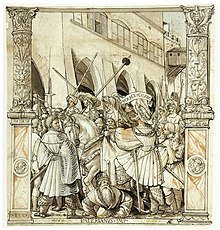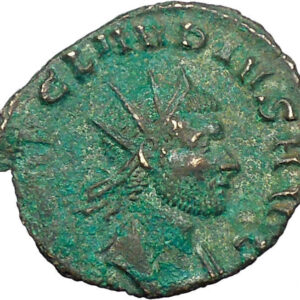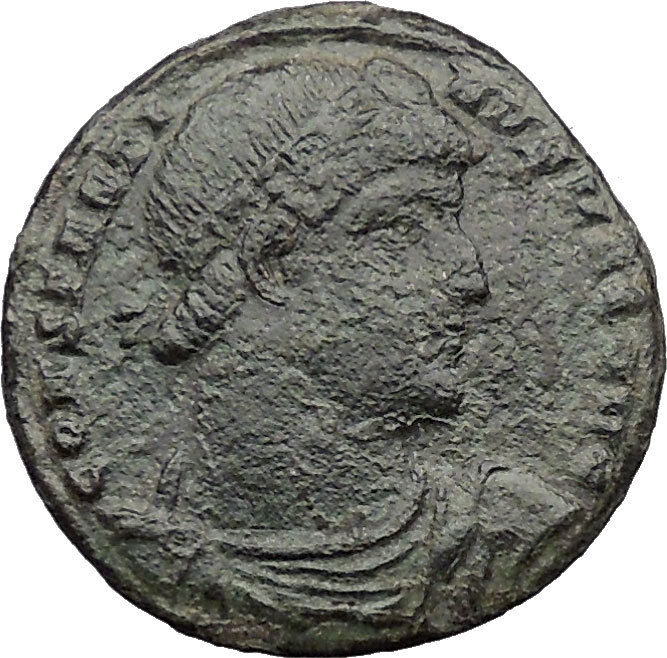|
Valerian I
–
Roman Emperor
: 253-260 A.D. –
Silver Antoninianus 22mm (1.87 grams) Struck circa 253-260 A.D.
Reference: RIC 89, C 65
IMPCPLICVALERIANVSAVG – Radiate, draped and cuirassed bust right.
FIDESMILITVM – Fides standing left, holding a standard in each hand.
You are bidding on the exact item pictured,
provided with a Certificate of Authenticity and Lifetime Guarantee of
Authenticity.
Standards

Roman military standards. The standards with discs, or signa
(first three on left) belong to centuriae of the
legion (the image does not show the heads of the standards – whether
spear-head or wreathed-palm). Note (second from right) the
legion’s
aquila
. The standard on the
extreme right probably portrays the
She-wolf
(lupa) which fed
Romulus
, the legendary founder of
Rome. (This was the emblem of
Legio VI Ferrata
, a legion then
based in
Judaea
, a detachment of which is
known to have fought in Dacia). Detail from Trajan’s Column, Rome

Modern reenactors parade with replicas of various legionary
standards. From left to right: signum (spear-head type), with
four discs; signum (wreathed-palm type), with six discs;
imago of ruling emperor; legionary aquila; vexillum
of commander (legatus) of
Legio XXX Ulpia Victrix
, with
embroidered name and emblem (Capricorn) of legion
Each tactical unit in the imperial army, from centuria upwards, had
its own standard. This consisted of a pole with a variety of adornments that was
borne by dedicated standard-bearers who normally held the rank of duplicarius.
Military standards had the practical use of communicating to unit members where
the main body of the unit was situated, so that they would not be separated, in
the same way that modern tour-group guides use umbrellas or flags. But military
standards were also invested with a mystical quality, representing the divine
spirit (genius) of the unit and were revered as such (soldiers frequently
prayed before their standards). The loss of a unit’s standard to the enemy was
considered a terrible stain on the unit’s honour, which could only be fully
expunged by its recovery.
The standard of a centuria was known as a signum, which was
borne by the unit’s signifer. It consisted of a pole topped by either an
open palm of a human hand or by a spear-head. The open palm, it has been
suggested, originated as a symbol of the
maniple
(manipulus = “handful”), the
smallest tactical unit in the
Roman army of the mid-Republic
. The poles were
adorned with two to six silver discs (the significance of which is uncertain).
In addition, the pole would be adorned by a variety of cross-pieces (including,
at bottom, a crescent-moon symbol and a tassel). The standard would also
normally sport a cross-bar with tassels.
The standard of a Praetorian cohort or an auxiliary cohort or ala was
known as a vexillum
or banner. This was a square flag,
normally red in colour, hanging from a crossbar on the top of the pole. Stitched
on the flag would be the name of the unit and/or an image of a god. An exemplar
found in Egypt bears an image of the goddess Victory on a red background. The
vexillum was borne by a vexillarius. A legionary detachment (vexillatio)
would also have its own vexillum. Finally, a vexillum
traditionally marked the commander’s position on the battlefield.[194]
The exception to the red colour appears to have been the Praetorian Guard, whose
vexilla, similar to their clothing, favoured a blue background.
From the time of
Marius
(consul 107 BC), the standard of all
legions was the
aquila
(“eagle”). The pole was surmounted
by a sculpted eagle of solid gold, or at least gold-plated silver, carrying
thunderbolts in its claws (representing
Jupiter
, the highest Roman god. Otherwise the
pole was unadorned. No exemplar of a legionary eagle has ever been found
(doubtless because any found in later centuries were melted down for their gold
content). The eagle was borne by the aquilifer, the legion’s most senior
standard-bearer. So important were legionary eagles as symbols of Roman military
prestige and power, that the imperial government would go to extraordinary
lengths to recover those captured by the enemy. This would include launching
full-scale invasions of the enemy’s territory, sometimes decades after the
eagles had been lost e.g. the expedition in 28 BC by
Marcus Licinius Crassus
against
Genucla
(Isaccea, near modern
Tulcea
, Rom., in the Danube delta region), a
fortress of the Getae
, to recover standards lost 33 years
earlier by
Gaius Antonius
, an earlier
proconsul
of
Macedonia
. Or the campaigns of AD 14-17 to
recover the three eagles lost by
Varus
in AD 6 in the
Teutoburg Forest
.
Under Augustus, it became the practice for legions to carry portraits (imagines)
of the ruling emperor and his immediate family members. An imago was
usually a bronze bust carried on top of a pole like a standard by an
imaginifer.
From around the time of Hadrian (r. 117-38), some auxiliary alae
adopted the dragon-standard (draco) commonly carried by Sarmatian cavalry
squadrons. This was a long cloth wind-sock attached to an ornate sculpture of an
open dragon’s mouth. When the bearer (draconarius) was galloping, it
would make a strong hissing-sound.
Decorations
The Roman army awarded a variety of individual decorations (dona) for
valour to its legionaries. Hasta pura was a miniature spear; phalerae
were large medal-like bronze or silver discs worn on the cuirass; armillae
were bracelets worn on the wrist; and
torques were worn round the neck, or on the cuirass. The highest
awards were the coronae (“crowns”), of which the most prestigious was the
corona civica, a crown made oak-leaves awarded for saving the life of a
fellow Roman citizen in battle. The most valuable award was the corona
muralis, a crown made of gold awarded to the first man to scale an enemy
rampart. This was awarded rarely, as such a man hardly ever survived.
There is no evidence that auxiliary common soldiers received individual
decorations like legionaries, although auxiliary officers did. Instead, the
whole regiment was honoured by a title reflecting the type of award e.g.
torquata (“awarded a torque”) or armillata (“awarded bracelets”).
Some regiments would, in the course of time, accumulate a long list of titles
and decorations e.g. cohors I Brittonum Ulpia torquata pia fidelis c.R..
In
Roman mythology
, Fides (“trust”) was the goddess of
trust
. Her Greek
equivalent was
Pistis
. Her temple on the
Capitol was where
the Roman Senate
kept state treaties with foreign countries, where Fides
protected them. She was also worshipped under the name Fides Publica Populi
Romani (“trust towards the Roman state”). She is represented by a young
woman crowned with an olive branch, with a cup or
turtle
, or a
military ensign in hand. She wears a white veil or stola; her priests wear
white.
Rome’s second king,
Numa Pompilius
instituted a yearly festival to Fides, and directed the priests to be borne to
Her temple in an arched chariot drawn by two horses and should conduct Her
services with their hands wrapped up to indicate protection.
VALERIAN I

Augustus:
A.D. 253-260 with Gallienus
Husband of Mariniana
Father of Gallienus
Grandfather of Valerian II and Saloninus
Publius Licinius Valerianus (c. 200 – after 260),
commonly known in
English
as Valerian or Valerian I,
was the
Roman Emperor
from 253 to 260.
Unlike the majority of the pretenders during the
Crisis of the Third Centuryy
, Valerian was of a
noble and traditional
senatorial
family. Details of his early life
are elusive, but for his marriage to
Egnatia Mariniana
, who gave him two sons: later
emperor Publius Licinius Egnatius Gallienus
and
Valerianus Minor
.
In 238 he was
princeps senatus
, and
Gordian I
negotiated through him for Senatorial
acknowledgement for his claim as emperor. In 251, when
Decius
revived the censorship with legislative
and executive powers so extensive that it practically embraced the civil
authority of the emperor, Valerian was chosen
censor
by the Senate, though he declined to
accept the post. Under Decius he was nominated governor of the
Rhine
provinces of
Noricum
and
Raetia
and retained the confidence of his
successor,
Trebonianus Gallus
, who asked him for
reinforcements to quell the rebellion of
Aemilianus

Coin of
Egnatia Mariniana
, wife of Valerian
and mother of
Gallienus
.
Rule and fall
Valerian’s first act as emperor was to make his son Gallienus
his colleague. In the beginning of his reign the affairs in Europe went from bad
to worse and the whole West fell into disorder. In the East,
Antioch
had fallen into the hands of a
Sassanid
vassal,
Armenia
was occupied by
Shapur I
(Sapor). Valerian and Gallienus split
the problems of the empire between the two, with the son taking the West and the
father heading East to face the
Persian
threat.
By 257, Valerian had already recovered Antioch and returned
the province of
Syria
to Roman control but in the following
year, the Goths
ravaged
Asia Minor
. Later in 259, he moved to
Edessa
, but an outbreak of
plague
killed a critical number of
legionaries
, weakening the Roman position in
Edessa which was then besieged by the Persians. At the beginning of 260,
Valerian was defeated in the
Battle of Edessa
and he arranged a meeting with
Shapur to negotiate a peace settlement. The ceasefire was betrayed by Shapur who
seized him and held him prisoner for the remainder of his life. Valerian’s
capture was a humiliating defeat for the Romans.
Gibbon
, in
The History of the Decline and Fall of the Roman Empire
describes Valerian’s fate:
The voice of history, which is often little more than the
organ of hatred or flattery, reproaches Sapor with a proud abuse of the
rights of conquest. We are told that Valerian, in chains, but invested with
the Imperial purple, was exposed to the multitude, a constant spectacle of
fallen greatness; and that whenever the Persian monarch mounted on
horseback, he placed his foot on the neck of a Roman emperor.
Notwithstanding all the remonstrances of his allies, who repeatedly advised
him to remember the vicissitudes of fortune, to dread the returning power of
Rome, and to make his illustrious captive the pledge of peace, not the
object of insult, Sapor still remained inflexible. When Valerian sunk under
the weight of shame and grief, his skin, stuffed with straw, and formed into
the likeness of a human figure, was preserved for ages in the most
celebrated temple of Persia; a more real monument of triumph, than the
fancied trophies of brass and marble so often erected by Roman vanity. The
tale is moral and pathetic, but the truth of it may very fairly be called in
question. The letters still extant from the princes of the East to Sapor are
manifest forgeries; nor is it natural to suppose that a jealous monarch
should, even in the person of a rival, thus publicly degrade the majesty of
kings. Whatever treatment the unfortunate Valerian might experience in
Persia, it is at least certain that the only emperor of Rome who had ever
fallen into the hands of the enemy, languished away his life in hopeless
captivity.
Valerian’s massacre of 258
According to the
Catholic Encyclopedia
article on
Valerian
:
Pope Sixtus
was seized on 6 August, 258, in
one of the Catacombs and was put to death;
Cyprian of Carthage
suffered martyrdom on
14 September. Another celebrated martyr was the Roman deacon
St. Lawrence
. In Spain Bishop
Fructuosus of Tarragona
and his two deacons
were put to death on 21 January, 259. There were also executions in the
eastern provinces (Eusebius, VII, xii). Taken altogether, however, the
repressions were limited to scattered spots and had no great success..
Death in captivity
An early Christian source,
Lactantius
, maintained that for some time prior
to his death Valerian was subjected to the greatest insults by his captors, such
as being used as a human footstool by Shapur when mounting his horse. According
to this version of events, after a long period of such treatment Valerian
offered Shapur a huge ransom for his release. In reply, according to one
version, Shapur was said to have forced Valerian to swallow molten gold (the
other version of his death is almost the same but it says that Valerian was
killed by being flayed alive) and then had the unfortunate Valerian skinned and
his skin stuffed with straw and preserved as a trophy in the main Persian
temple. It was further alleged by Lactantius that it was only after a later
Persian defeat against Rome that his skin was given a cremation and burial. The
role of a Chinese prince held hostage by Shapur I, in the events following the
death of Valerian has been frequently debated by historians, without reaching
any definitive conclusion.

The Humiliation of Emperor Valerian by
Shapur I
, pen and ink,
Hans Holbein the Younger
, ca. 1521
Some modern scholars believe that, contrary to Lactantius’
account, Shapur I
sent Valerian and some of his army to
the city of Bishapur
where they lived in relatively good
condition. Shapur used the remaining soldiers in engineering and development
plans. Band-e Kaisar (Caesar’s dam) is one of the remnants of Roman
engineering located near the ancient city of
Susa. In all the stone carvings on Naghshe-Rostam, in Iran, Valerian
is respected by holding hands with Shapur I, in sign of submission.
It is generally supposed that some of
Lactantius
‘ account is motivated by his desire
to establish that persecutors of the Christians died fitting deaths; the story
was repeated then and later by authors in the Roman Near East “fiercely hostile”
to Persia.
Other modern scholars tend to give at least some credence to
Lactantius’ account.
Valerian and Gallienus’ joint rule was threatened several
times by
usurpers
. Despite several usurpation attempts,
Gallienus secured the throne until his own assassination in 268.
Owing to imperfect and often contradictory sources, the
chronology and details of this reign are very uncertain..
|













